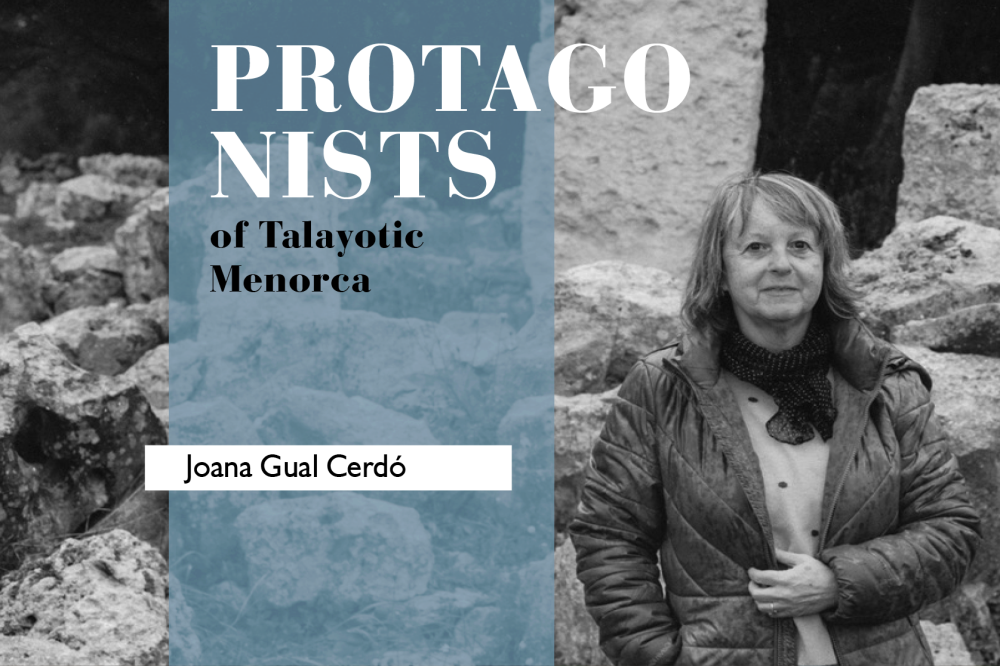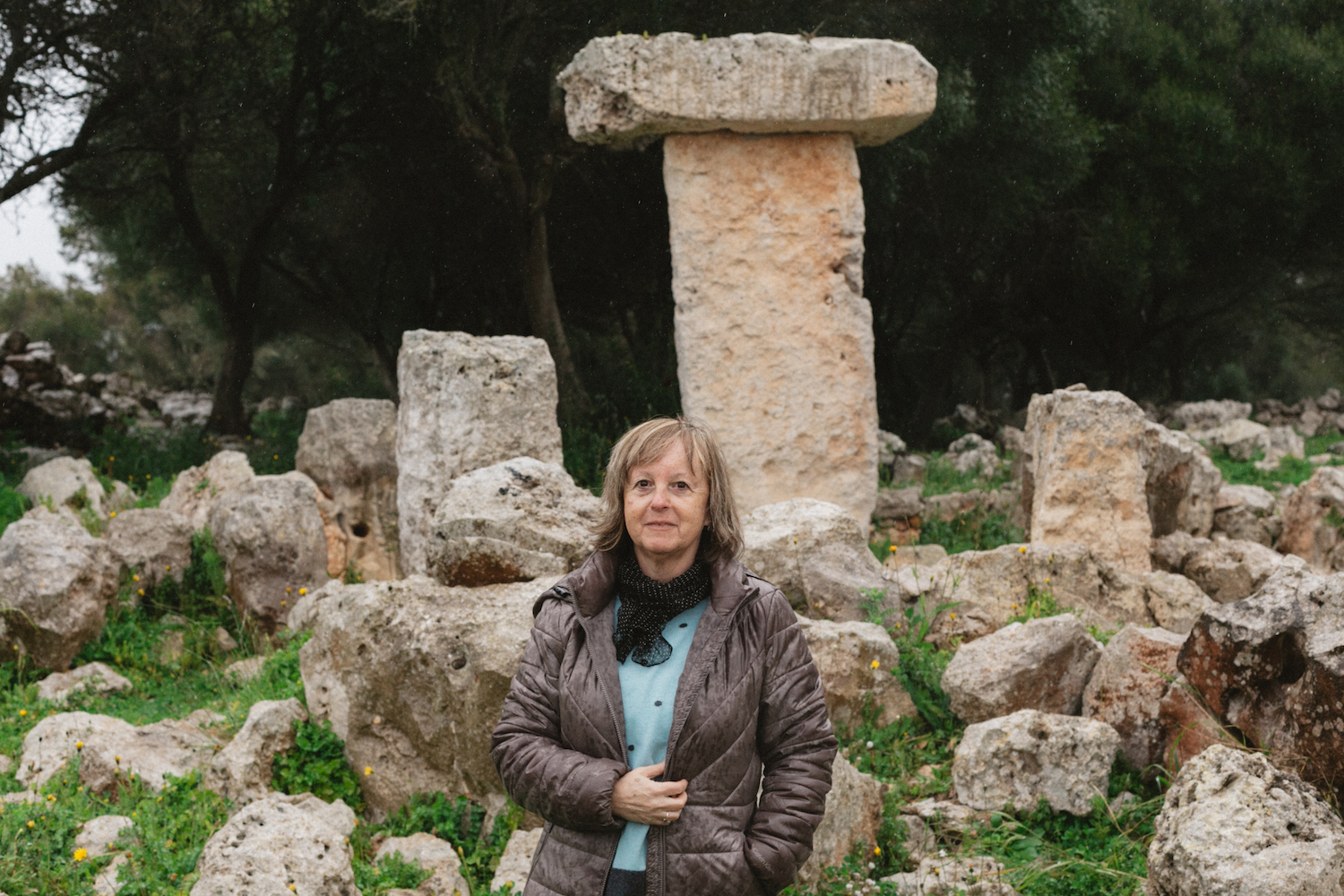 Mallorcan archaeologist Joana Gual Cerdó is a member of the Scientific Council and of the Governing Council of the Talayotic Menorca Agency. She earned her degree in History at the University of the Balearic Islands with a study of "Bronze figures in the protohistory of Mallorca", and also holds a postgraduate qualification in archaeological heritage management from the Open University of Catalonia. She has been a member of the History and Archaeology Section of the Institut d’Estudis Menorquins since 1989, serving as a member of the Scientific Committee of the Menorca Biosphere Reserve Consortium between 1996 and 2004.
Mallorcan archaeologist Joana Gual Cerdó is a member of the Scientific Council and of the Governing Council of the Talayotic Menorca Agency. She earned her degree in History at the University of the Balearic Islands with a study of "Bronze figures in the protohistory of Mallorca", and also holds a postgraduate qualification in archaeological heritage management from the Open University of Catalonia. She has been a member of the History and Archaeology Section of the Institut d’Estudis Menorquins since 1989, serving as a member of the Scientific Committee of the Menorca Biosphere Reserve Consortium between 1996 and 2004.
Aside from her research work, at the start of her career she worked at the Mallorca Museum and the Menorca Museum from 1986 to 1995, when she took up a position as archaeologist at the Consell Insular de Menorca, serving as head of the Historical Heritage Service during the periods 2007-2015 and 2019-2022.
How did you first become interested in archaeology?
I always enjoyed history when I was little, and as a youngster I read a book we had at home, Gods, Graves and Scholars by C.W. Ceram, which made an impression on me above all through the account of the discovery of Tutankhamen's tomb. I am hardly the first in that! During my time at university, I joined the archaeological dig that Prof Guillem Roselló-Bordoy organised with the Mallorca Museum, of which he was the director, and focused on archaeology for my graduation thesis.
And what attracted you to the study of Talayotic culture?
My answer is that of an archaeologist already established in Menorca. When I arrived, I was thrilled to see the first taula, Torralba d'en Salort. I hadn't imagined anything so big and impressive, and that emotion is still with me today, although I have been familiar with them for years. I have an interest in all aspects of knowledge about Talayotic culture, so am not drawn to any particular feature, but my professional career has also pushed me towards the taulas because in the early 1990s I formed part of the team running the research into the small taula at Binissafullet, alongside staff from the Menorca Museum. We were able to document and understand the rituals held there, and a potential timeframe for its use.
Over your long career as a researcher, you have headed various archaeological projects. Which made the biggest impression on you, or marked a turning point in your career?
I would say the first archaeological dig on which I had a senior role: the ceramic workshop close to the talayot at Can Jordi, in Santanyí, Mallorca, because it gave me an understanding of what the job involved in terms of the scientific interpretation, document registration and methodology demanded in archaeological intervention. And then after I moved to Menorca, aside from Binissafullet, I was also particularly drawn to the digs at the Trebalúger talayot and hypogeum XXI at Calescoves. The smallest projects I have taken part in also had their own appeal: Son Catlar, So Na Caçana, Trepucó, Punta de S’Escullar ...
In truth, there is no one turning point in my career as a researcher. I began working at the Consell quite early on, and that changed what research meant for me. Working at the Historical Heritage Service I had some unforgettable experiences. The most impressive was abseiling down to the Cova del Mussol, a cliff above the sea, with Pere Arnau alongside as my guide, because I had never done anything like that. I am proud to say that I was the first female archaeologist to reach the cave! It was also exciting to spend time in the dark in the secret chamber at Cova des Càrritx waiting for the light to return, and heading back along the shore at Calescoves with a bag full of human bones.
 Of the archaeological projects now underway in Menorca, which of them most arouses your interest in terms of its possible implications for our understanding of Talayotic culture?
Of the archaeological projects now underway in Menorca, which of them most arouses your interest in terms of its possible implications for our understanding of Talayotic culture?
In my role I have to keep track of almost all the projects, as our department is responsible for authorising all archaeological interventions and ensuring that the rules of good professional practice are followed. There can be no doubt that the whole nomination process has given the incentive to gather more resources for research, so as to provide content for the dossier in terms of greater knowledge of the island's prehistory, and there have been more projects because of that.
I couldn't highlight any one project, because they all help to extend that knowledge. I do think, though, that the Cornia Nou project demands recognition, as it showed for the first time the structure of the internal construction of a large talayot, and revealed a series of contemporaneous rooms connected to it, which is probably a pattern repeated in other villages.
Mention should also be made of the research at the Sa Mitja Lluna mine on Illa d’en Colom, as the first discovery of mine workings in the island's prehistory; and the research into the late Talayotic houses at Torre d'en Galmés conducted by different teams, which also allowed the recovery of spectacular architectural spaces which hugely enrich the site for visitors.
You belong to the Governing Council and Scientific Council of the Talayotic Menorca Agency. What has your experience been of how the nomination has developed?
The most intense experience came at the start, because I and the other archaeologists at the Heritage Service (Simó Gornés, Cristina Rita, Toni Ferrer and Quim Pons) were involved in preparing the dossier and the stages of the administrative process.
During the early years, working on the initial project with the coordinator of the dossier, the Cuban architect and ICOMOS member Ángela Rojas; going through all the review stages in Spain, which were a real success, up to the meeting in November 2016 at the UNESCO headquarters in Paris, where we presented a fairly good defence of Talayotic Menorca, but felt that we still had some way to go, as the Committee informed us a few weeks later. Although we continued our work, it was not enough, and in the end, following the instructions of ICOMOS, we began a new dossier and approach, coordinated by Cipriano Marín.
The fact is that a process lasting so many years includes a little of everything. A lot of positive and gratifying moments, but also times when you feel discouraged. As a whole, though, I see the nomination as a positive for our archaeological heritage, because the recognition of its value has taken hold among the island's population, the efforts to protect and research our heritage are now better understood. It has started a journey which will undoubtedly continue.
Now that a date has been set for the World Heritage Committee in September, what are your feelings? Are you optimistic as to inclusion on the World Heritage List?
I have a good feeling and am optimistic because we have been working hard to include in the dossier all the technical considerations that were pointed out. I must nonetheless strike a note of caution, because we cannot be certain; we can't break out the champagne until the Committee has issued its opinion.
With your experience as an archaeologist, and in the field of historical heritage management, what challenges do you see for Talayotic Menorca, beyond obtaining this international recognition?
There are plenty of challenges. The most immediate is to keep the Talayotic Menorca Agency up and running, as it needs to develop the Management Plan for the sites included in the nomination. I would highlight a few aspects of this management role:
- Guarantee the conservation of archaeological heritage, with pressure from visitors and tourists expected to increase if the World Heritage nomination is successful.
- Have professional specialists in place for the different types of archaeological intervention found on the island.
- Reach out to universities and research centres regarding the island's projects, as such bodies are essential for their development.
- Obtain economic resources to fund publications and editions of explanatory reports and studies produced in archaeological interventions.
- Find incentives to encourage private owners or administrators to participate in proper management.
- Promote the island's museums as sites responsible for the safekeeping, conservation, research and presentation of the archaeological heritage sites included in the nomination.